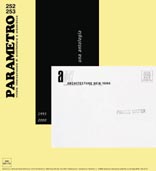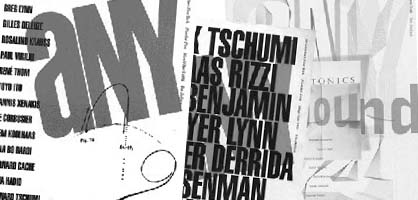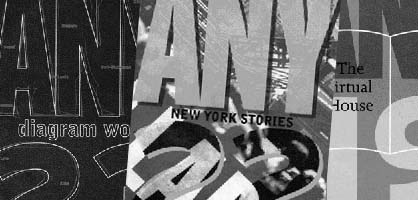|
|
| home > files |
| An(y)alysis:
Cynthia Davidson talks with herself Cynthia Davidson |
 |
Issue
0 of ANY magazine,
acronym for Architecture New York and prefix distinguishing the subjects
dealt with by the 10 annual meetings held all around the world from
1991 to 2000, was published in 1993. The magazine, seminars and their
published acts are within the orbit of the Anyone Corporation, founded
by Arata Isozaki, Peter Eisenman, Ignasi de Solà-Morales and Cynthia
Davidson, ANY's editor, who, after 27 issues, decided to stop her publication
in October 2000. Parametro
252/253 analyses her collection with the cards edited by Julian
Adda, Luka Skansi, Marcello Gizzarelli, Luca Galofaro, Anna Barbara,
Rossella Gotti, Gisella Bassanini, 2a+p, Sergio Pirrone, Andrea Guardo,
Gabriele Mastrigli, Silvio Cassarà, Fabio Quici, Ruggero Baldasso, Cesare
Birignani, Giovanni Damiani, Cecilia Bione, Maddalena Scimemi, Daniele
Pisani, Furio Barzon, Gianluca Milesi, Giovanni Corbellini, Brett Terpeluk
and Raffaella Laezza. The monographic nature of the different treatments
ranges from the works of individual personalities –James Stirling, Tadao
Ando, Buckminster Fuller, Colin Rowe, Manfredo Tafuri – and the critical
discussion on the results of architectural competitions – for the Tate
Gallery and the enlargement of Chicago's IIT by Mies – to the reasoning
on change and contamination suffered by architecture in the last decade,
investigating Electrotecture, the role of game and memory and the instrument
of the diagram. An anthological section collects essays never published
in Italian by Cynthia Davidson, Rem Koolhaas, Peter Eisenman, Robert
Somol, Christian Hubert, Sanford Kwinter, Greg Lynn, Wolf Prix, Jean-Louis
Cohen, Kevin Roche, Richard Meier, Francesco Dal Co, Ralph Rugoff, Toyo
Ito, Ben van Berkel e Caroline Bos, Pierluigi Nicolin, Detlef Mertins
and John Hejduk. With the cards, Parametro
252/253 deals with an interview by Pier Vittorio Aureli to Peter Eisenman
concerning the current condition of the architectural discipline and
with an updated rereading by Cynthia Davidson on the experience of ANY.
We would like to thank Parametro for allowing us to anticipate Cyntia
Davidson's text to our readers. |
|||
| [in italiano] | I
understand that the editors of Parametro asked you to write an
essay about ANY magazine for this issue, and that you declined.
Yet you agreed to this interview. Why is that? As the issue was explained to me, the editors had every intention to conduct a critical review of all of the issues of ANY. While I am very self-critical of my own work, I didn't feel that I had the distance necessary to be critical of the issues of ANY, at least not this close to the time of their publication. It's been four years since ANY ceased publication. At what point in time does one look back and evaluate the effect of a magazine like ANY? Perhaps I shouldn't have introduced the idea of time, because I have in mind to write an essay about the speed at which things are becoming history today. Fukuyama may have declared the end of history, but I think the movement of ideas and events is so fast now that, in effect, culture is continually asking, Is it history yet? In other words, is it over yet? Can we file it away? Of course, to become history is better than to be simply forgotten. While I believe in history as a viable source of ideas, ANY set out to question history as a category of belief. How did the idea of history shape ANY? Since there is no one idea of history, this question is problematic. However, you cannot do a magazine of critical thinking in architecture without being aware of previous publications in this vein, in part because there are not very many of them, or at least not many we remember. Italy has one of the best records in that regard, for example, Spazio and Controspazio. In the U.S. we had Oppositions, which dealt directly with interpretations of history, and then Assemblage, which fused theory and history. ANY viewed history more as a resource or a backdrop against which to test new thinking. In other words, a view of history as a continuity that the new cannot completely escape from, but that the new can cast in a different light, perhaps.  We know that ANY is an acronym for Architecture New York. What is the significance of the name? First of all, ANY was not an acronym. We had to give it the status of an acronym because the word any as a title confused people. To ask at the newsstand for "ANY magazine" makes no sense in English because it is not specific. It does not denote this or that magazine. So we said ANY was an acronym for Architecture New York, which became the subtitle of the magazine, but not the subject of the magazine. Second, ANY wasn't a singular project but was developed out of the Anyone project, a series of annual multidisciplinary, cross-cultural conferences on architecture that began in 1991. The idea of undecidablity, which was in the air, fueled the theoretical basis of the Anyone project. Since it was to take place in the ten years prior to the end of the century, or the end of the millennium, the idea of undecidability not only suggested that nothing was fixed in terms of architectural thinking but also that both history and the future could be seen as undecidable, that is, as no longer fixed referents. The conferences were framed by redefining the ten compound "any" words in the English language: anyone, anywhere, anyway, anyplace, anywise, anybody, anyhow, anytime, anymore and anything. The proceedings were published each year in books of the same name. The ideas generated by the conferences clearly needed further investigation and comment that the books alone, in their annual publication, could provide, so in 1993 we launched ANY to sustain and broaden the discussion in between the annual conferences.  ANY may have been the second publication of the Anyone project, but you still had to decide what kind of magazine it should be. I would say there are three types of architecture magazines: those for the profession, shelter magazines for mass audiences, and those for critical thinking. ANY was interested in the latter category, in looking critically at how we think about architecture and how we act on that thinking. To situate that activity, ANY adhered to the agenda of the Anyone project, which positioned architecture as the host of a multidisciplinary discussion with other disciplines –science, mathematics, art, philosophy, and so forth– which participate in a discussion grounded in or affected by architecture. ANY rarely addressed buildings per se, and when we did, the buildings in question were framed by broader questions, such as how the critic sees or what constitutes the virtual in architecture or the idea of lightness. The professional magazines do a good job of disseminating nice pictures of built work and commenting on this or that aspect of the project. ANY was more interested in the kinds of thinking or ideas that are generated from and around architecture and less interested in the kinds of products architecture uses or produces. Since ANY was basically published in the 1990s, do you see it as a record of that time? I think ANY reflects certain kinds of thinking that were prevalent in the 1990s. It certainly is not a complete record. All of the covers still hang on the wall over my desk, and when I look at them I think of the things we didn't have the chance to explore. At one point we were trying to develop an issue on the seeming surge of work by artists like Mike Kelley and Jorge Pardo, which was clearly drawing on architectural tropes for its conceptual underpinning. Issues we did do, on memory, on fear, on the virtual, tried to respond to what people were thinking or talking about. The themes of the magazine were different from the themes developed in the annual Any conferences in part because they were often developed with guest editors. There were internal exchanges too. Mark Taylor's issue (No. 4) on "electrotecture," a term he coined in 1994, when Internet "communities" began to challenge the concept of public space, led to Wes Jones's issue (No. 10), "mech in tecture," which featured the transcript of a three-week on-line chat room about the mechanical in architecture. So yes, ANY is certainly a reflection of a time. You could also say that it ceased publication because the time of undecidability as a conceptual construct came to an end. Oddly enough, undecidability seems more of a real factor now than it was in the nineties.  Don't you think that the graphics tie ANY to the 1990s? That's possible, but the kind of nonhierarchical layering, or even blurring, of text and image that occurred in ANY is still very prevalent in website design and television advertising. The difference is that those media move and the printed piece does not. Layering helped us to lessen the importance of the image, which is so prominently featured in mass media publications, and to try to establish each page as a site of ideas, where image and text were inseparable manifestations of the same idea. Admittedly, sometimes this meant the text wasn't always legible, which was a problem. This also occurred when graphic design was developing an increasingly strong presence in the design world in general, due in part, I think, to designers beginning to understand what could be accomplished with the synthesis possible in the computer, as opposed to working with text and images as separate elements. By the time we reached the last issue, the challenge was to resist the synthesis and dare to be straightforwardly clear. The last issue, number 27, is called Being and Nothingness. This theme seemed to be more about the demise of ANY than anything happening in architecture at the time. Being and nothingness is a universal idea. It was about number 27 insofar as you can construe this concept as relating to one's demise: we are, and then we become nothing, that is, we no longer physically exist. So yes, you could say it was more about ANY than any one idea being investigated in architecture. But it is also about process, about creativity, about history, all the things that constitute the making and being of architecture. About how an idea appears and then vanishes, whether because it was forgotten too soon or just proven irrelevant. One of the most important things about history is its susceptibility to revision, its own innate undecidability. Even a certain history can become nothing, meaningless, in light of ensuing events. You could also say that the folding of 27, rather than the usual stitched binding, signaled not only the undoing of the magazine but also, metaphorically, the undoing of the idea of folding in architecture. At one point we were talking about an issue on the Deleuzian idea of the fold, and our designers suggested simply folding the issue rather than binding it. That seemed a bit obvious to me, even pretentious, so we tabled the idea. But when we got to the end, the unbound folded issue could also be seen as an unfolding, or opening up to other possibilities, because you had to take the issue apart to read it. Was the act of unfolding also a critique of ANY itself? Not explicitly. Because it was not trimmed and bound, you could also ask whether it was unfinished or coming apart. That is, the condition of the magazine as an object could be seen as undecidable, which simply seemed like an appropriate ending point for this particular project. When the Anyone conferences ended, the magazine stopped too. We waited awhile to see what we should do next. Last fall we launched Log, a journal on architecture and the city, which is also probably as good a self-critique of ANY as one can find. Log is small, black-and-white, graphically straightforward, and not thematic. In that sense Log is a critical comment on what has gone on before, including the tabloid size and thematic organization of ANY. But in its simplicity, Log is straddling the line between the easy and the difficult, or between shape and form; in other words, it is operating in a more dialectical world than the one the themes of ANY may have synthesized. At the same time, despite Log, I don't think of ANY as being over. We may not be publishing new numbers, but students still ask for it. Sometimes it appears that certain issues are being used by in architecture classes. Last fall there was a big run on ANY 23, on the diagram, which Ben van Berkel and Caroline Bos guest edited; right now there's a run on 25/26, the issue on Tafuri, which the late Ignasi Sola-Morales guest edited. For me, that makes ANY seem still very much alive. |
[25sep2004] | ||